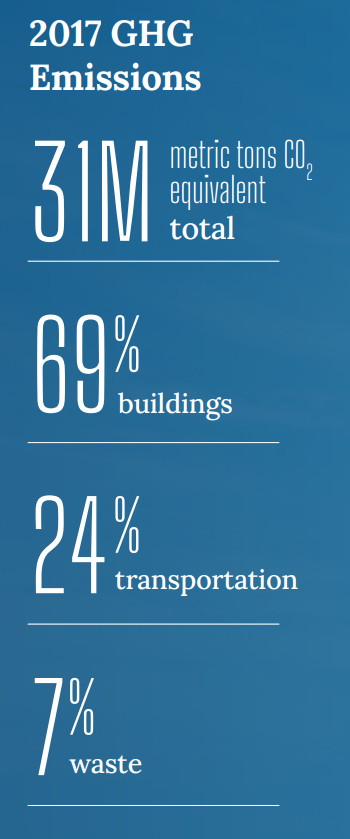Electrify Chicago
An independent tool for viewing City of Chicago building data
According to the
2022 Chicago Climate Action Plan,
69% of Chicago's emissions come from buildings, making
building emissions our biggest challenge and our biggest opportunity as a city
to tackle climate change. At Electrify Chicago, we showcase building performance using
publicly available data supplemented by community-submitted photographs and building
owners.
Start by looking at Chicago's buildings with the highest greenhouse gas intensity i.e. emissions per square foot. Large, efficient, buildings can perform much better than very inefficient small buildings on this metric.
New Article
📰 $30 Million In Missed Fines
The City Of Chicago failed to collect $30 million in potential fines from the building benchmarking ordinance, reducing transparency and accountability.
Legislative update! 🎉
As of late January 2024, legislation is being introduced to require new use more efficient forms of water and space heating, via the Clean And Affordable Buildings Ordinance (CABO), which will reduce the number of highly polluting and inefficient buildings that end up on this site.
If you're in Chicago,
write to your alderman to support the CABO!
Chicago Buildings by Greenhouse Gas Intensity
Note: Data includes large Chicago buildings with data from 2022, unless explicitly stated otherwise.
Note: This data only includes buildings whose emissions are reported
under the
Chicago Energy Benchmarking Ordinance. According to the City “As of 2016,
this list includes all commercial, institutional, and residential buildings larger than
50,000 square feet.” This dataset is also then filtered to only buildings with
reported emissions > 1,000 metric tons CO2 equivalent.
The latest year of data is from 2022, but we update the site regularly when new data is available, and some buildings may have failed to report that year, and only have older data available.
| Property Name / address | Primary Property Type |
Greenhouse Gas Intensity (kg CO2 eq./sqft) |
Total Greenhouse Emissions (metric tons CO2 eq.) |
|---|---|---|---|
|
3158 3184 N CLARK ST
🕰️
3158 3184 N CLARK ST
| Multifamily Housing | 2.6 kg/sqft | 196 tons |
|
2720 2730 N Greenview Ave
🏆
2720 2730 N Greenview Ave
| Multifamily Housing | 2.6 kg/sqft
Lowest 2%
| 139 tons
#17 Lowest in Chicago*
|
|
StStan_School
🕰️
1255 N Noble St
| K-12 School | 2.6 kg/sqft | 248 tons |
|
1444 N ORLEANS ST
1444 N ORLEANS ST
| Multifamily Housing | 2.6 kg/sqft
Lowest 2%
| 343 tons
Lowest 12%
|
|
Ed Kaplan Family Institute for Innovation and Tech Entrepreneurship
🕰️
3137 S FEDERAL ST
| College/University | 2.5 kg/sqft | 178 tons |
|
Carroll-Rose-CPS
🕰️
(CPS)
2929 W 83rd St
| K-12 School | 2.5 kg/sqft | 213 tons |
|
1001 W BELMONT AVE
1001 W BELMONT AVE
| Multifamily Housing | 2.5 kg/sqft
Lowest 2%
| 191 tons
Lowest 2%
|
|
8101 8141 S CICERO AVE
🏆
8101 8141 S CICERO AVE
| Strip Mall | 2.5 kg/sqft
Lowest 2%
| 163 tons
#28 Lowest in Chicago*
|
|
Fullerton Parkway Towers
415 W FULLERTON PKWY
| Multifamily Housing | 2.5 kg/sqft
Lowest 2%
| 579 tons
Lowest 32%
|
|
2144 N. Lincoln Park Condominium Association
2144 N Lincoln Park West
| Multifamily Housing | 2.5 kg/sqft
Lowest 2%
| 706 tons
Lowest 41%
|
|
4801 W. Peterson Ave
🕰️
4801 W Peterson Ave
| Office | 2.5 kg/sqft | 226 tons |
|
15 25 S THROOP ST
15 25 S THROOP ST
| Multifamily Housing | 2.5 kg/sqft
Lowest 2%
| 186 tons
Lowest 2%
|
|
420 432 W ONTARIO ST
420 432 W ONTARIO ST
| Multifamily Housing | 2.5 kg/sqft
Lowest 2%
| 203 tons
Lowest 2%
|
|
Austin 1900 Building
🕰️
1900 n. Austin
| Distribution Center | 2.5 kg/sqft | 1,882 tons |
|
Coeval 2
🏆
1419 S Wabash Ave
| Multifamily Housing | 2.4 kg/sqft
Lowest 2%
| 129 tons
#15 Lowest in Chicago*
|
Data Source:
Chicago Energy Benchmarking Data
